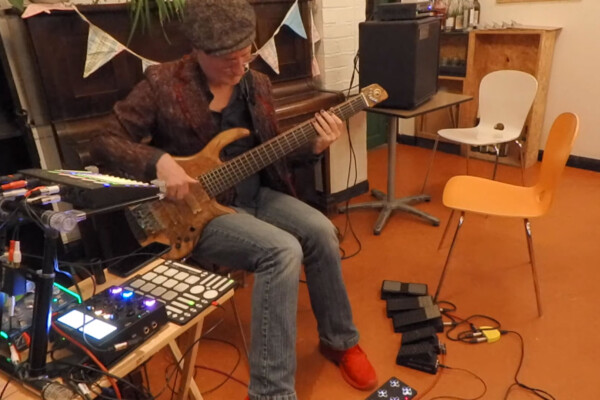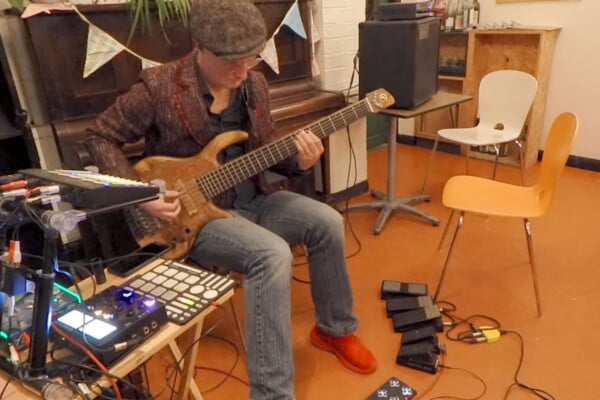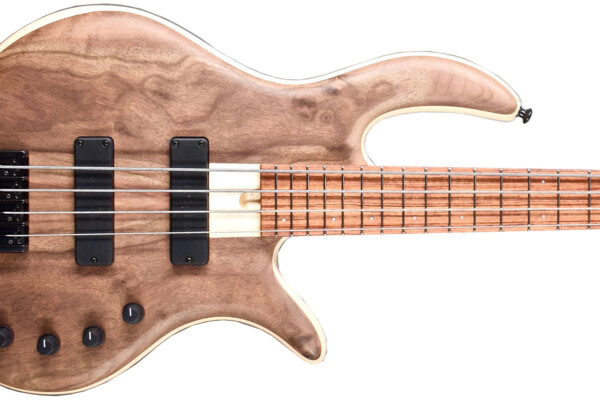Beauty and Desolation: An Interview with Steve Lawson
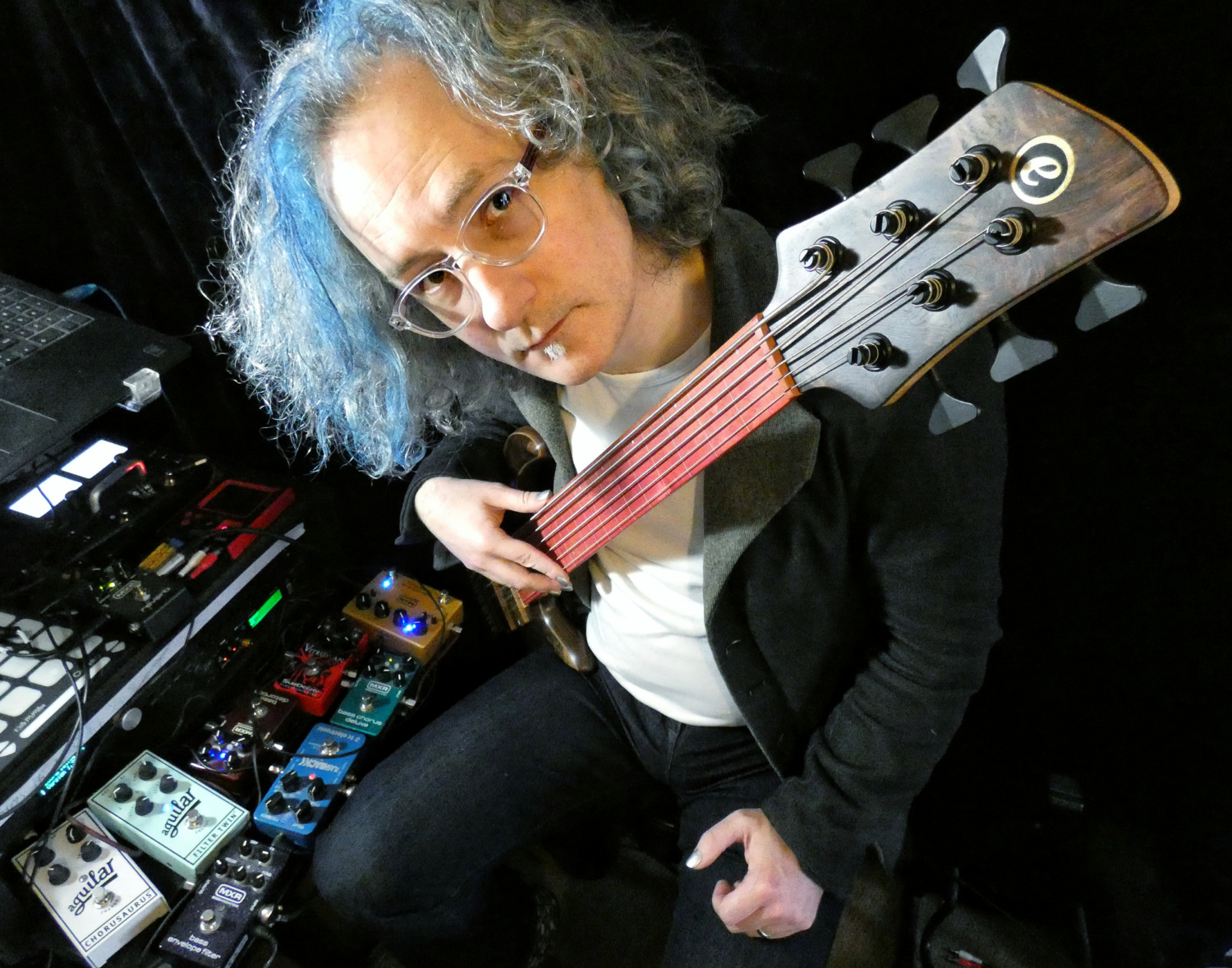
Steve Lawson’s new album, Beauty and Desolation, could not have a better title. The completely improvised album teeters between delicate melodies and ominous soundscapes that seem to be a perfect picture of our times. He takes us on this sonic journey with just his bass – and a boatload of gear.
Improvisation and being in the moment are key to Lawson’s work. This has led him to study the relationship between performer and audience and how that affects our musical experiences. While he is pursuing higher education on the subject, he gets to dig into these even deeper with his fans in part thanks to their subscription to his music on BandCamp. This gives the opportunity for listeners to access his whole catalog and receive special, otherwise unreleased material, which they can talk to the bassist about.
We caught up with Lawson to talk about Beauty and Desolation, symbolism in music, and his improvisational method. Stick around until the end for an overview of his incredible gear setup from the man himself.
I love the new album. It’s gorgeous, and it’s also haunting in places, so I think the title is pretty apt.
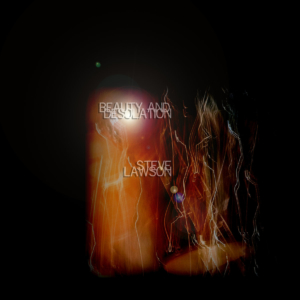 It’s interesting how the theme emerged. I didn’t go into it thinking, “This is what I’m playing about.” It wasn’t written, and of course, none of my stuff is written beforehand. So I wasn’t thinking it was a concept album as I was making it, but then there was this emerging textural thing that came out. There was a story being told. Everything was evolving from that place of gorgeousness to something more gnarly towards the end. As I said in the sleeve notes, we were in the middle of the summer where it was, “This is really great! It’s so hot” to “Oh crap, we’re all going to die.” There’s nothing that goes fully apocalyptic.
It’s interesting how the theme emerged. I didn’t go into it thinking, “This is what I’m playing about.” It wasn’t written, and of course, none of my stuff is written beforehand. So I wasn’t thinking it was a concept album as I was making it, but then there was this emerging textural thing that came out. There was a story being told. Everything was evolving from that place of gorgeousness to something more gnarly towards the end. As I said in the sleeve notes, we were in the middle of the summer where it was, “This is really great! It’s so hot” to “Oh crap, we’re all going to die.” There’s nothing that goes fully apocalyptic.
There was a tune on my last album, PS You Are Brilliant, called “If They Had Won” that does get to this violent, destructive ending where everything builds to total chaos. But nothing on this album felt like it needed to go to that level of shock. It’s a funny thing when the music informs you of where it wants to go. It’s not like, “I think I need to do this.” It’s more like you’re playing it and in the middle of that experience, you’re thinking, “Hm. I need to follow where this goes.” There’s an internal logic and integrity of what this music is and it needs to go a certain way.
That gets filtered through the pile of toys and my physical ability to play and occasionally reroute audio. I reroute the audio from the Looperlative to the second Kaos pad in order to make things evolve in certain ways. There’s a bringing together of the aspects with the sense of the music wanting to go somewhere. It will feel like it’s pulling in one direction and I have to figure out how to do that. The fact that the first and last tunes are static stay where they are, that wasn’t planned beforehand. In either one, I could have put a beat in there or added a piano sound, but at no point did it ask for that. There was no support request that came into my little IT desk that I sit on here. So there is a weird thing of being somewhat subservient in the moment to where the music wants to go.
And it’s all just intuition that’s guiding you.
Obviously, I have a language and a vocabulary and I practice things. One of the things you can hear on this record is that harmonically it goes to some completely different places to anything I’ve done before. The last record had some of that, but since the death of Allan Holdsworth, I rediscovered his work and a couple of the harmonic things that he did. In the middle of his tunes where he’d go to a new harmony, I’d think, “That’s brilliant. I need to do that.” So there’s a bit of that in there harmonically. Also, a part of it was working with Rich Brown. He came to the London Bass Guitar Show earlier this year and we recorded together. The recordings we did are interesting because there isn’t a massive pile of gnarly harmony in there, but his knowledge of both extended harmony and complex rhythmic variations is greater than almost any other bass player I’ve ever come across. Just being around him [inspired me] to pour more of that into what I do. The funny thing is I don’t think I’ve come anywhere near that. It would take me years to get close to Rich’s facility and the things he does, but I was able to absorb that as an influence and say, “What’s the Steve take on this?” Those are there as a start point, but I also have the last 31 years of playing bass and accumulated ideas and technique.
There are things aesthetically I want to explore. Another thing I mentioned in the sleeve notes was the whole hip-hop thing. It is fascinating on a purely aesthetic level what hip-hop has done to how we perceive rhythm. It came out at a time in the ’80s where everything was on a grid because sequencers were really basic. By using turntables, hip-hop introduced a whole nuance into electronic music that wasn’t there before. Even through the ’90s and into the new millennium, that was exaggerated to a ridiculous degree through the influence of a producer called J Dilla, who was the inspiration behind D’Angelo’s Voodoo, which of course was Pino [Paladino] and Questlove emulating what the drummer calls “playing drunk.” So there’s an aesthetic there that as a looping musician, I’m not interested in making four-square, technically immaculate loops at all.
But I also like what hip-hop represents politically. I find it weird when everyone talks about hip-hop being incredibly narcissistic and obsessed with bling and guns and whatnot. To me, it’s protest music. Even the origins of gangster rap with NWA and Public Enemy, which I wouldn’t really call gangster at all, even that was the sound of protest music. It was the sound of a bunch of very, very angry and disenfranchised people rising up. It did the same thing as Woody Guthrie did in the ’50s and punk did in the late ’70s and early ’80s. It came out of the spoken work within reggae, as well. The last poets may have been the first hip-hop artists to do that. So I feel some level of affinity with it as a protest movement as much as I do a wonky electronic aesthetic. When I’m telling stories through the music, that’s a sound I draw on for its meaning and its symbolism as much as I do the fact that I love the music and want to see where it can go.
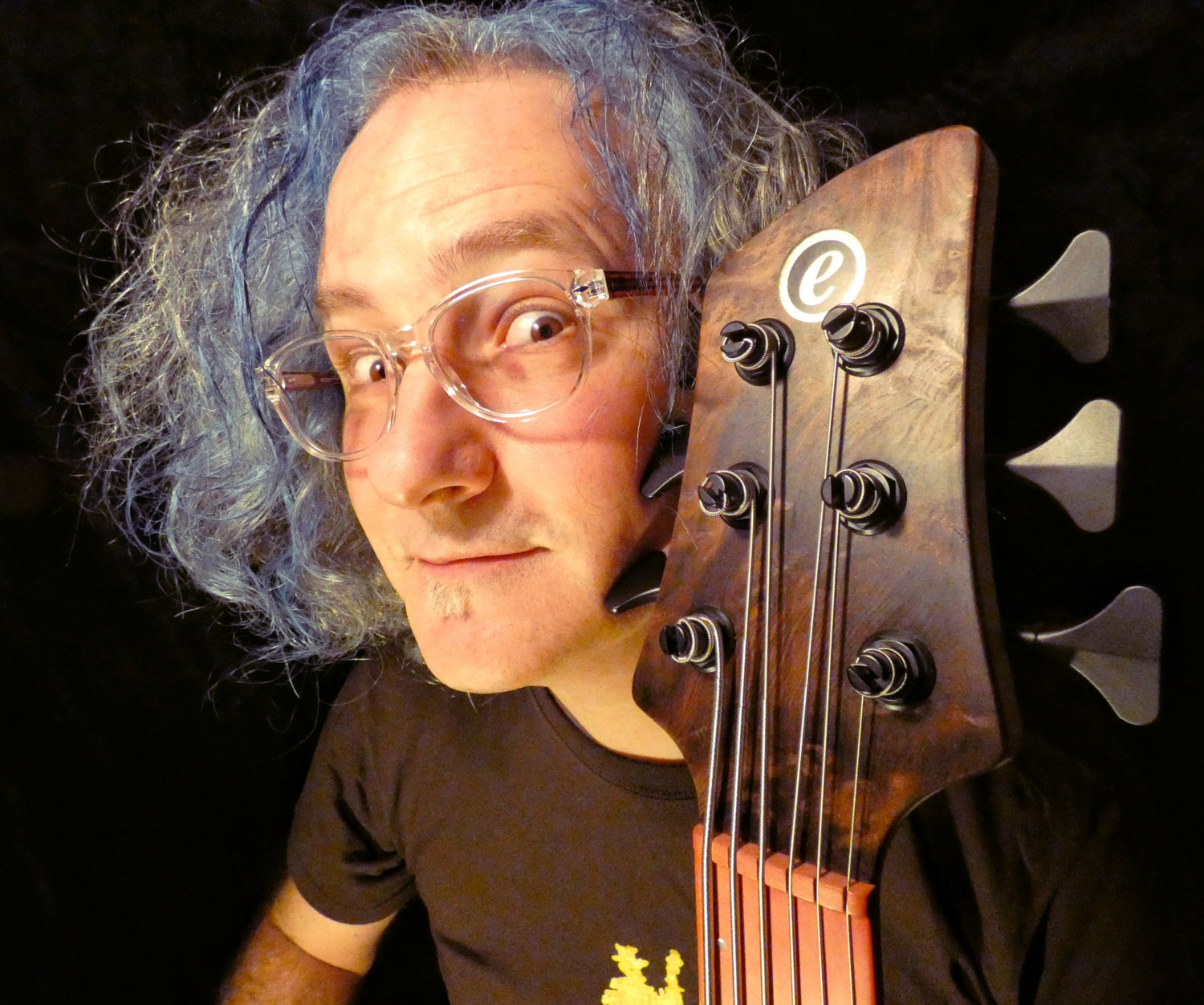
Do you draw on the symbolism of a lot of styles, or just that one in particular?
That’s a really, really good question. I do because I use jazz in the same way. I use jazz harmony and things that sound “jazzy” as a very specific color to tell a part of a story. My attraction to jazz is almost in spite of its jazz rather than because I love it. I can go to the ballet without being a ballet fan and appreciate the exquisite of a well-choreographed ballet. I’m kind of the same way with jazz. There are bits of it that can make me cold. Now I’m going to massively contradict myself because if I were to pick a favorite genre of music it would be ’70s era Miles Davis, which I see as its completely own thing that spawned a whole bunch of other stuff. But that was Miles reacting against jazz. It’s interesting to hear the two records he did in between the swinging second great quintet and before he went electric. There’s Filles de Kilimanjaro and Miles in the Sky. They don’t have a whole lot of swing on there. You’ve got Tony Willams basically inventing hip-hop drumming. They’re acoustic, broadly, but with electric piano. They kind of herald where it was about to go with Bitches Brew, but they don’t go that far. They were the link. Those two records are overlooked, I think, as far as being the signpost where jazz was going. That’s the kind of stuff I connect with. I don’t really want to hear the “ting, ting-ta ting, ting” in four, but I do want the freedom. Again, it’s what it represents politically. I see Miles and Coltrane and Mingus as these extraordinary political figures. What they represented, particularly within segregation-era America and the transition from pre to post, that they were absolute figureheads of what was happening there. That’s what I draw from. Jazz is another one of these things that has a depth and a weight and a resonance to it.
But then I also use really complex harmony and extreme dissonance to represent confusion and the sense of swirling or falling. There’s some stuff that is physically rooted to emulate a physical experience and there are other things that are much more symbolic.
As an example on the new record is the song “Nobody Wants Reality Anymore”, which comes from a line in the movie “Batteries Not Included” where a character says, “Dude, this is the 80’s – nobody wants reality anymore.” When I played that, I hit stop on the recording and fell about laughing. It was like, “How did I end up writing this weird 80’s cop show song?” It feels like it ought to be a stakeout tune. I thought, “This is mad.” I’m a huge Hall & Oates fan, but it had never come out in my songs before. It took me quite a few listens to let go of the comedy of that and realize it is a great bit of music.
That was a thing I recorded and laughed, but then decided it needed to go on the album because it’s part of the story. That line from that film sort of fits with that narrative that we’re holding onto all this beautiful stuff. I was looking at the weather, particularly, but it also applies to when we see opulence and people showing off. We say, “Look – everything is going well because the glamorous end of things is going well.” Then we ignore the opposite end where there’s this enormous disparity between rich and poor. The weird one for me is watching Elon Musk on Twitter, who I find to be one of the most despicable human beings I can imagine. You see people celebrating him because he’s built a car and he wants to go to space. But he’s piling up money when people are dying because they can’t afford food in America. It’s not even that you have to externalize it. There’s just no reason for anyone to be a billionaire.
It’s weird to be talking about something as concrete as that from the perspective of being an instrumentalist. I’m not writing for film or dance and it’s not like there’s a figurative expression of what I’m doing. It is completely abstract, so for all of this people can listen to it and say, “No, all I hear is clever bass playing,” and I’ll say “Great!” If you’re here because you like the fretless bass sound, that’s fine. But in my own journey as a creative person and the relations and dialogue between my output and the inner working of my brain, that exchange is where all the interest happens. It happens three ways because I also have this conversation with my audience. One of the joys of having the BandCamp subscription going on is that I have this group of people who are engaged to a great degree with the body of work, which is why I started a Ph.D. about it.
What is the PhD based around?
 I had a few months of mental block where this year, but then I had a breakthrough where I found my theoretical framework. I started reading a lot more about phenomenology, which is just the study of experience and what it says about the nature of being. From an improviser’s perspective and the ephemerality of what we create in the moment. The idea within phenomenology is that the essence of any particular thing is what the people around it agree it to be, so it’s all about perception. We get away from this idea that things have an essential state or essential anything. There’s no ontology to any of this. It’s all about understanding things through our experience. So as an improviser, it’s a beautiful lens through which to look at how my audience experiences what I do and to divide that up into recorded and live. The recorded material is repeatable so we have a central thing we can talk about. Every experience of that is different because of the system you’re playing it on, how you feel, what else you’ve been listening to, where you are, how much caffeine is in your body, and all those kind of things. But it’s semi-fixed, whereas live you’ve got the momentary experience and memory.
I had a few months of mental block where this year, but then I had a breakthrough where I found my theoretical framework. I started reading a lot more about phenomenology, which is just the study of experience and what it says about the nature of being. From an improviser’s perspective and the ephemerality of what we create in the moment. The idea within phenomenology is that the essence of any particular thing is what the people around it agree it to be, so it’s all about perception. We get away from this idea that things have an essential state or essential anything. There’s no ontology to any of this. It’s all about understanding things through our experience. So as an improviser, it’s a beautiful lens through which to look at how my audience experiences what I do and to divide that up into recorded and live. The recorded material is repeatable so we have a central thing we can talk about. Every experience of that is different because of the system you’re playing it on, how you feel, what else you’ve been listening to, where you are, how much caffeine is in your body, and all those kind of things. But it’s semi-fixed, whereas live you’ve got the momentary experience and memory.
That’s why one of the tracks is called “Language and Memory.” There was a scholar named Bruce Kuhn who said that image is the language of memory. I like that because it made me think, “How are people remembering what I’m doing as a musician?” How does that idea of it being a linguistic thing and the language being pictorial, how does that representation overlay onto what I’m doing? To what degree does the gestural aspect of my performance [count]? I look up and joke with the audience sometimes, but I also have to manipulate with a lot of stuff with the pedals. It’s a bit like watching close-up magic for other musicians, I think. That makes it an intimate experience – you draw people in.
Together, the sound and visual aspects form this body of residual evidence of what they’ve just experienced. The thing they make a value judgment on is all these different images. In terms of understanding what the audience gets from music, the realization is that we’re not just talking about notes and sounds disembodied. We’re talking about an entire experience that involves the expectations that they bring to it and what their friends around them have said and the degree to which I respond to that. We were talking about the things that go into the record, but on a gig, the thing that goes into the music is the audience. They are the source for all of it.
There’s a liminality in terms of what that space represents. What is in between me and the audience? How do we bridge it? How do we do that in a way that feeds the aesthetic and the message? Then, what’s the degree to that happening being captured on a recording, and are people aware of that? Musicians love talking about magic. We love the idea of things being transcendent, hence “Transcendence and Decay”. We love the idea that there are things over and above us. There are those moments, and sometimes they stay there and sometimes they come crashing down. It’s very fragile. Can that be captured in a recording?
Pop has always been a really banal forum for those kinds of conversations. It’s always been marginal music communities that have messed with this: punk, free jazz, folk, spoken word. Nobody joins those bands to get rich. Once you take the quest for economic and status elevation out of it, you suddenly can start to mess with those things because everything is flattened in terms of hierarchy. As a solo bass player, that’s kind of it. There’s some sort of false elevation online with people who are venerated for a while, then there is Victor Wooten, who is everybody’s god.
The Ph.D. is a space for me to explore that as a set of relationships and doing it through the lens of their experience instead of mine is a way of getting out of thinking about myself the whole time. That’s another problem for artists.
When you sit down to make music, do you have any idea of what you’re about to play? Do you find a few notes and then decided to build something around that?
This comes up a lot in conversations about improv. A lot of what we learn about improv is in the context of soloing over jazz changes. When the creation of music is spontaneous and you’re feeding off of things, you have a number of starting points. Say I walk into a room and a bloke is sitting there and he smiles. I’m going to start a conversation in a number of fairly generic ways. “Hi, I’m Steve,” or anything like that. There are a fixed number of possibilities. If I went in and made some mad statement about the world, he would say, “What the hell?” So I have a range of choices to start. I have in mind a destination for the music. Music doesn’t exist in the ether. It lands in people’s ears, and I have an idea of who those people are. When I’m recording, it’s my subscribers. They’re a great bunch of people because their tolerance for my experimentation is pretty high. They know I’m never going to throw out anything that’s any old bollocks. I’m trying to bring an experience to them that is entertaining and meaningful. I’m allowed to get shocking with them and that’s ok.
Steve’s Gear:
Right, this is going to be the most comprehensive list of my gear I’ve ever done! My current set up is in some ways simpler than it looks. The main bulk of the signal path is a straight line, that goes from a Dunlop volume pedal to my floor board that has an MXR Sub Octave Bass Fuzz, a Dunlop Mini Crybaby Bass Wah, Pigtronix Philosopher Micro and Darkglass VMT, into my Jule Monique preamp, and from there into a Subdecay Vitruvian Mod, TC Electronic Flashback and an Aguilar Filter Twin. That lot goes through a mini Kaoss Pad (the Mini KP is a real pain, cos it steps down the level quite a bit between in and out, but it’s just such a cool musical interface!) into my MOD Duo. The Duo is where the bulk of the processing happens – I run a whole load of virtual pedal boards in there for a range of different kinds of sounds. They keep adding new pedals to the store, and they’re almost all free to use, so I’m always experimenting with new sounds in it! From the Duo, it goes through an MXR Reverb before reaching the heart of my studio and live set up (which are the same thing) – the Keith McMillen K-Mix – this is the newest addition, and it’s just so cool! It’s an 8 in/10 out soundcard, but also a control surface, so I can use it as a mixer, to route whichever inputs I want to the Looperlative for looping, and even use as a MIDI controller for the Looperlative or the MOD Duo. From the K-Mix I send a stereo signal to the Looperlative, and that comes back either directly, or through an aux that goes to my second Mini Kaoss Pad. And then for the drums and keys, I have my Keith McMillen Quneo which is playing sounds that are hosted in FL Studio on my laptop, that’s also used to record everything multi-tracked! I also have a Keith McMillen Softstep 2 for MIDI foot control of both the MOD Duo and the Looperlative.
Bass-wise, I have my two main basses which are my Elrick Gold Series SLC signature fretted and fretless 6s. I still play my Moduluses a lot – they are all custom, 6 String fretted and fretless, and my original 4 string fretted from the early 90s. These are all strung with Dunlop strings – Superbright Nickels on the Elricks, Superbright Stainless on the 4 string and Dunlop custom flats on the Modulus 6s. I also have an amazing Rick Turner Renaissance 5 string fretless that doesn’t get anywhere near the use it deserves.
My amp set up is a pair of Aguilar TH350 heads and SL112 cabs that I run in stereo. I’ve been using them for many years and still can’t quite believe how great they sound. Just the perfect amp for what I do.
My cables are almost all Evidence Audio, and my cases are all by Slick Bag, I’ve got an eBow, two Pedaltrain boards, slides by Latchlake and Dunlop, expression pedals by Dunlop and an SKB Flyer rack to keep it all in! And for live streaming seminars and masterclasses, I have a Focusrite 2i2. There is a mountain of other pedals that get swapped in and out to keep things fresh. I’ve been really enjoying the Pigtronix Mothership 2 recently, and the MXR Chorus and Envelope Filter are perennial favorites.

